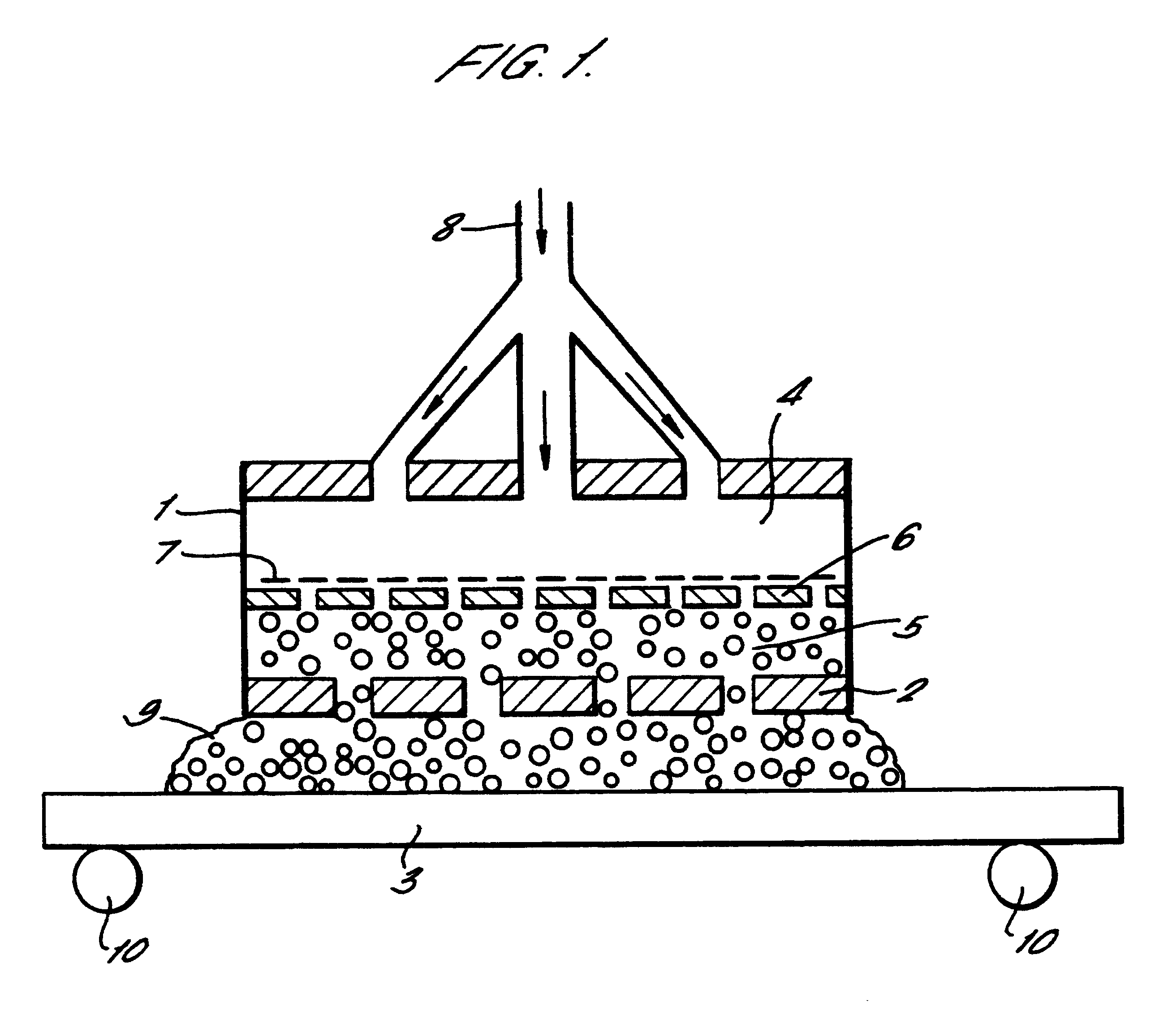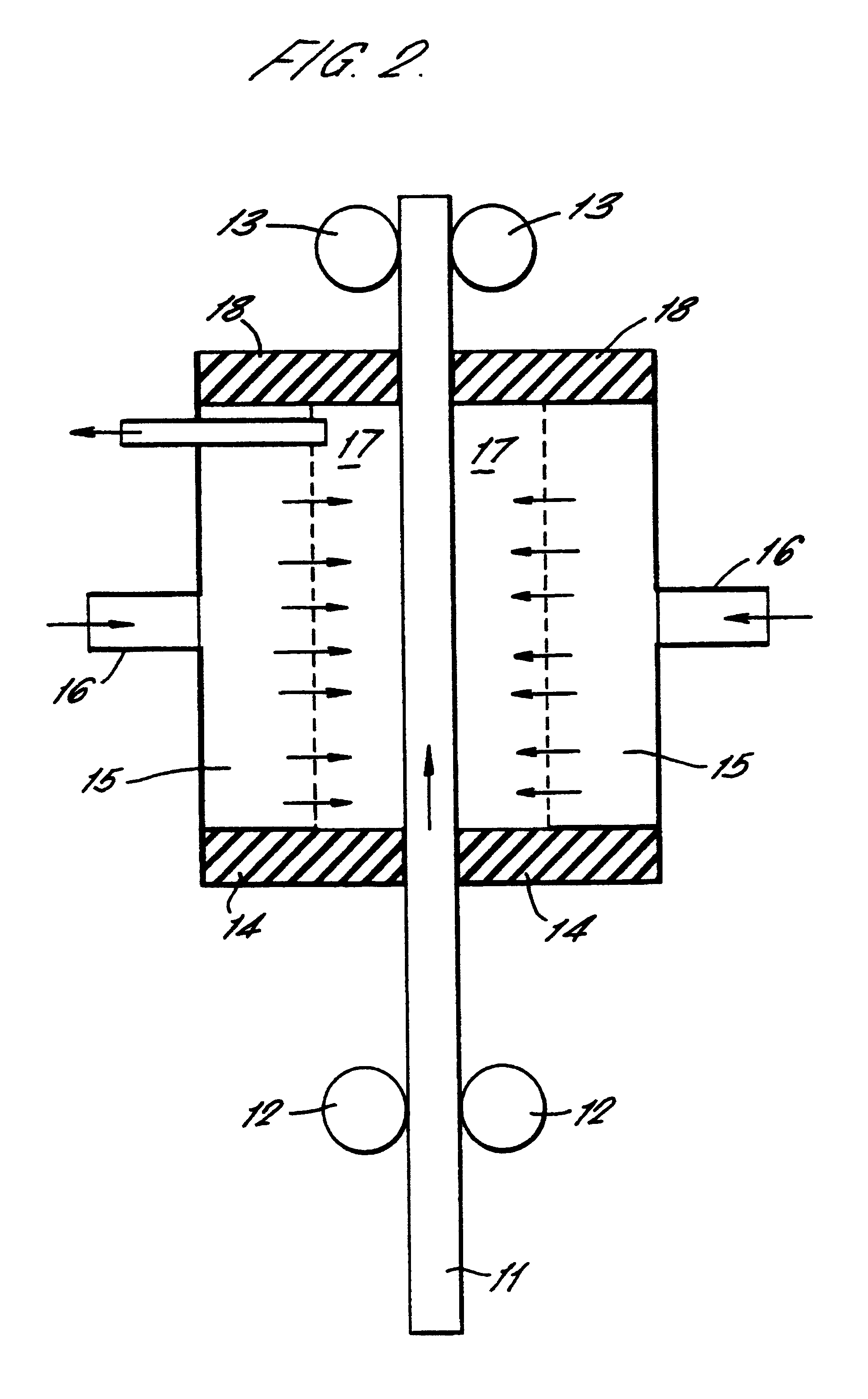Process and apparatus for cleaning and/or coating metal surfaces using electro-plasma technology
- Summary
- Abstract
- Description
- Claims
- Application Information
AI Technical Summary
Problems solved by technology
Method used
Image
Examples
example 1
A continuous strip of low-carbon steel covered on both sides with a layer of black mill-scale was passed vertically through the closed apparatus shown in FIG. 2 at a steady speed of about 1 cm / sec. The width of the strip was 10 cm and the working area of each anode was 10 cm.times.10 cm.
An electrolyte consisting of a 10% solution of sodium bicarbonate in water was pre-heated to 90.degree. C. and caused to flow through holes in the anode plates situated on either side of the strip into a working gap (anode-to-workpiece distance) of 10 mm.
Initially the electrolyte pooled at the bottom of the chamber, being partially retained by the rubber seals. A DC voltage was applied to the anode (the strip being earthed) and automatically limited to about 10V on account of the high current flow of above 40 amps.
The flow-rate of the electrolyte was gradually decreased until resistive heating of the pooled liquid electrolyte at the bottom of the chamber caused it to boil and foam, filling the workin...
example 2
A continuous low-carbon steel strip as in Example 1 was passed horizontally through an apparatus as shown in FIG. 1 at a speed of around 1 cm / sec. An electrolyte as described in example 1 was caused to flow through holes in the anode plate into the working gap above the strip, which was set at 10 mm. A DC voltage of 200V is applied to the anode. Initially the electrolyte consisted of liquid streams, and a stable plasma was established on the surface of the strip by gradually reducing the flow-rate of the electrolyte.
The internal heater in the anode assembly was turned on, raising the temperature of the electrolyte and causing it to fill the working gap substantially in the form of a foam. While the process was running, the working gap was increased to 20 mm without destroying the plasma or disrupting the cleaning process.
Without a foaming electrolyte (that is, using only liquid electrolyte streams) such an increase in the working gap causes the plasma to be quenched. Thus larger wor...
example 3
A stationary copper sheet was cleaned of oxide in an apparatus as shown in FIG. 2. The process was essentially as described in Example 1 except that the electrolyte consisted of a saturated solution of sodium chloride heated to 90.degree. C. In this case, however, the electrolyte exhaust tube was restricted by a clamp in order to generate a slightly elevated pressure in the enclosed working chamber, estimated at 112 kPa.
The copper sheet was cleaned and the resulting surface was smoother than that produced using a liquid electrolyte, at atmospheric pressure and without foaming, in an apparatus such as that shown in FIG. 1.
PUM
| Property | Measurement | Unit |
|---|---|---|
| Electric potential / voltage | aaaaa | aaaaa |
| Temperature | aaaaa | aaaaa |
| Pressure | aaaaa | aaaaa |
Abstract
Description
Claims
Application Information
 Login to View More
Login to View More - R&D
- Intellectual Property
- Life Sciences
- Materials
- Tech Scout
- Unparalleled Data Quality
- Higher Quality Content
- 60% Fewer Hallucinations
Browse by: Latest US Patents, China's latest patents, Technical Efficacy Thesaurus, Application Domain, Technology Topic, Popular Technical Reports.
© 2025 PatSnap. All rights reserved.Legal|Privacy policy|Modern Slavery Act Transparency Statement|Sitemap|About US| Contact US: help@patsnap.com



